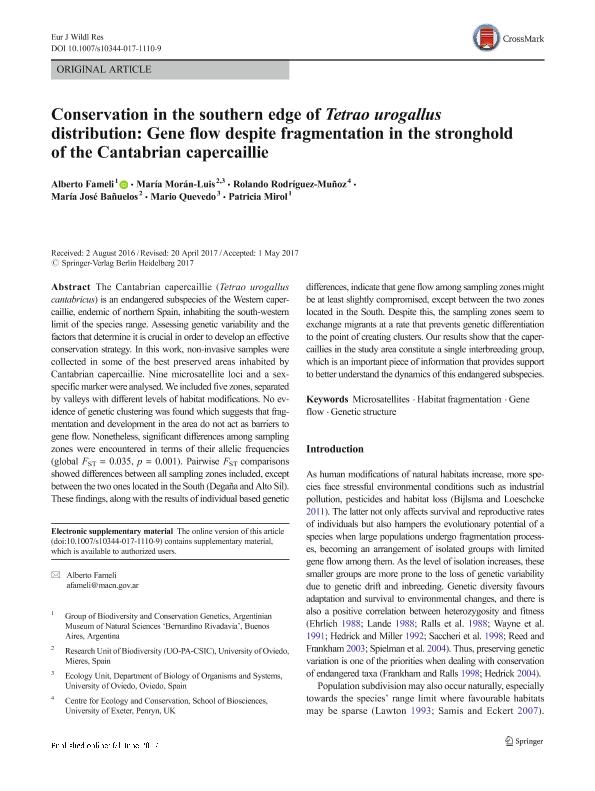Artículo
Conservation in the southern edge of Tetrao urogallus distribution: Gene flow despite fragmentation in the stronghold of the Cantabrian capercaillie
Fameli, Alberto Francisco ; Morán Luis, María; Rodríguez Muñoz, Rolando; Bañuelos, María José; Quevedo, Mario; Mirol, Patricia Monica
; Morán Luis, María; Rodríguez Muñoz, Rolando; Bañuelos, María José; Quevedo, Mario; Mirol, Patricia Monica
 ; Morán Luis, María; Rodríguez Muñoz, Rolando; Bañuelos, María José; Quevedo, Mario; Mirol, Patricia Monica
; Morán Luis, María; Rodríguez Muñoz, Rolando; Bañuelos, María José; Quevedo, Mario; Mirol, Patricia Monica
Fecha de publicación:
06/2017
Editorial:
Springer
Revista:
European Journal of Wildlife Research
ISSN:
1612-4642
Idioma:
Inglés
Tipo de recurso:
Artículo publicado
Clasificación temática:
Resumen
The Cantabrian capercaillie (Tetrao urogallus cantabricus) is an endangered subspecies of the Western capercaillie, endemic of northern Spain, inhabiting the south-western limit of the species range. Assessing genetic variability and the factors that determine it is crucial in order to develop an effective conservation strategy. In this work, non-invasive samples were collected in some of the best preserved areas inhabited by Cantabrian capercaillie. Nine microsatellite loci and a sex-specific marker were analysed. We included five zones, separated by valleys with different levels of habitat modifications. No evidence of genetic clustering was found which suggests that fragmentation and development in the area do not act as barriers to gene flow. Nonetheless, significant differences among sampling zones were encountered in terms of their allelic frequencies (global FST = 0.035, p = 0.001). Pairwise FST comparisons showed differences between all sampling zones included, except between the two ones located in the South (Degaña and Alto Sil). These findings, along with the results of individual based genetic differences, indicate that gene flow among sampling zones might be at least slightly compromised, except between the two zones located in the South. Despite this, the sampling zones seem to exchange migrants at a rate that prevents genetic differentiation to the point of creating clusters. Our results show that the capercaillies in the study area constitute a single interbreeding group, which is an important piece of information that provides support to better understand the dynamics of this endangered subspecies.
Palabras clave:
GENE FLOW
,
GENETIC STRUCTURE
,
HABITAT FRAGMENTATION
,
MICROSATELLITES
Archivos asociados
Licencia
Identificadores
Colecciones
Articulos(MACNBR)
Articulos de MUSEO ARG.DE CS.NAT "BERNARDINO RIVADAVIA"
Articulos de MUSEO ARG.DE CS.NAT "BERNARDINO RIVADAVIA"
Citación
Fameli, Alberto Francisco; Morán Luis, María; Rodríguez Muñoz, Rolando; Bañuelos, María José; Quevedo, Mario; et al.; Conservation in the southern edge of Tetrao urogallus distribution: Gene flow despite fragmentation in the stronghold of the Cantabrian capercaillie; Springer; European Journal of Wildlife Research; 63; 3; 6-2017; 58-70
Compartir
Altmétricas



